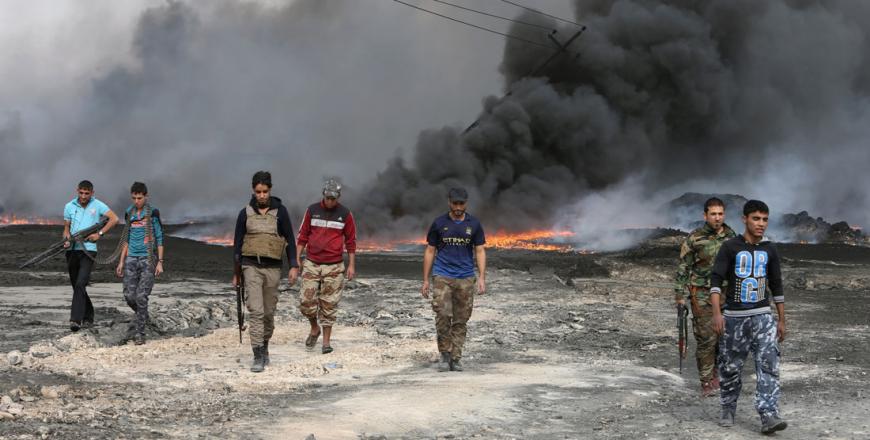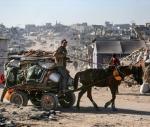You are here
Rush hour on Mosul’s ‘displacement highway’
By AFP - Mar 30,2017 - Last updated at Mar 30,2017

Civilians queue to collect food during food delivery in western Mosul, Iraq, on Thursday (Reuters photo)
MOSUL — On west Mosul's Baghdad street, thousands of displaced Iraqis flee the fighting with their meagre belongings but similar numbers walk in the other direction, heading straight back into the war-torn city.
The street is currently the main corridor for civilians fleeing the battle between the Daesh teror group and the government forces trying to root them out of their last strongholds.
It is also the main entry point for those already returning to the homes they fled in the early stages of the offensive federal forces launched last month on the western side of Mosul.
The contrary flows of trudging civilians cross quietly, each on their half of the road, sometimes parted by a screeching ambulance taking wounded residents or fighters to the nearest hospital.
"They are fleeing areas that have not been liberated yet like Yarmuk, Matahen and Aabar neighbourhoods," said Ghanem Ahmad, a 48-year-old in a grey traditional gown.
"But we the people of Risala feel safe now and are returning to our homes, it's better," he said.
Ghaith Lafi, a 21-year-old student wearing a red hoodie, decided to park his cart stacked with chocolate bars and wafers on Baghdad street a few weeks ago.
"This street is full, as if it was judgement day," he said.
"There are other places like this where displaced people cross but now Baghdad street... is the safest street and the one people use the most to flee," he said.
"I just stand here on 'displacement road' — some people come to me with nothing so I give them things for free."
Mosul is witnessing one of the biggest battles since Daesh extremists proclaimed a so-called ‘caliphate’ over parts of Iraq and Syria nearly three years ago, but it was never emptied of its population like other cities were when government forces moved back in.
Short-term displacement
Residents were largely unwilling to leave. Those who eventually had to because the fighting got too intense are trying to return as soon their neighbourhood is retaken, even when the battle still rages a few blocks down.
The corridor is secured by forces from the elite Counter-Terrorism Service and other units but mortar rounds still whizzed over the streams of displaced civilians while gunships unleashed thudding bursts of machinegun fire on nearby extremist targets.
"Why would we be scared? Thank God, we Iraqis have no fear, never as long as he is present," said Shetat Mohammed, a veiled woman in her late 50s, pointing to the sky as she and her family walked towards the plumes of black smoke rising above Mosul.
There were an estimated 1 million people in Iraq's second city before security forces began a huge offensive in mid-October.
More than 300,000 were displaced at one point but not all went to camps set up by the United Nations and other aid groups.
Many have simply moved from one neighbourhood to another as the front line itself moved, attempting to remain as close as possible to their abandoned homes.
Faisal Hamid, carrying nothing but two framed training certificates, was among the droves of civilians fleeing the city but hoped to walking homeward on Baghdad street within days.
"I'll be back, God willing, in two or three days. The security forces told us to come back when the area is secured," he said.
Aziz Ali, a 47-year-old with a grey beard, is making the Baghdad street journey for the third time in 10 days already.
He and his children tried to return last week to the Mosul Al Jadida neighbourhood they had fled a few days earlier, but found very few other families there and no water to drink.
He decided to leave again and temporarily move to the east bank of Mosul, which is split in two halves by the Tigris river.
"My uncle's house is there... hopefully the children can go to school."
Related Articles
BAGHDAD —Nearly half a million people have fled their homes since Iraqi forces launched an operation to wrest Mosul back from extremists exa
MOSUL, Iraq — Iraqi forces have recaptured nearly 90 per cent of west Mosul from the Daesh terror group and extremists in the city are on th
EAST OF MOSUL, Iraq — Iraqi forces battled Daesh militants on the eastern edge of Mosul on Tuesday as the two-week campaign to recapture the















